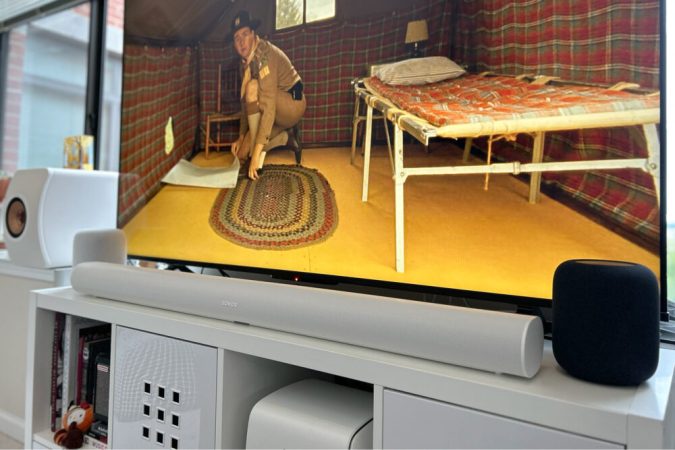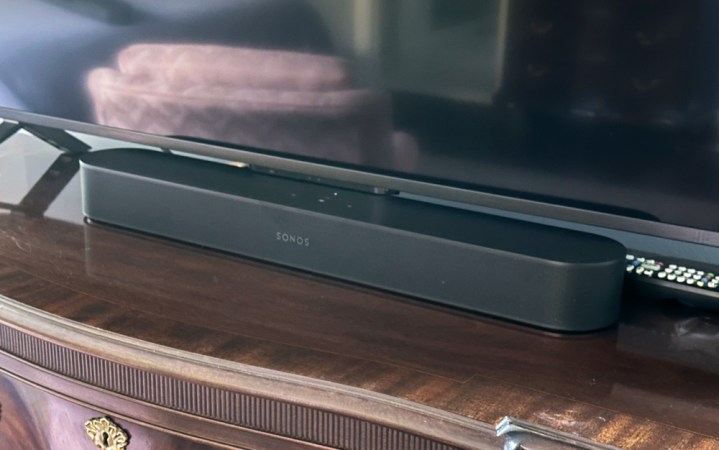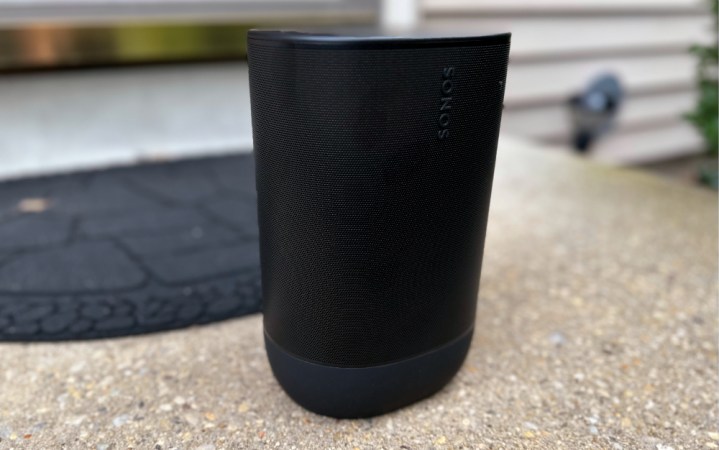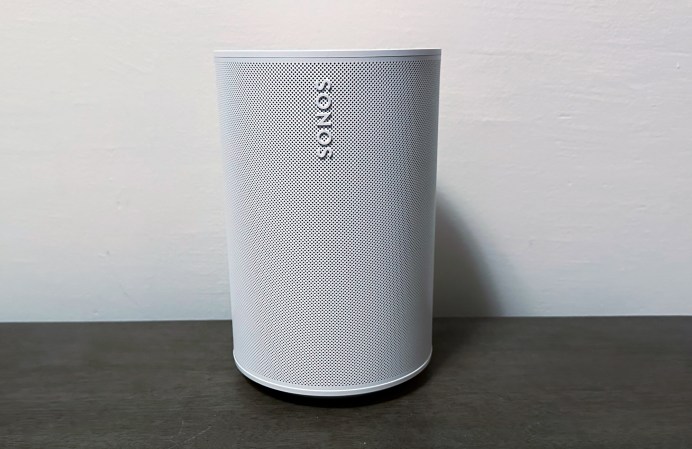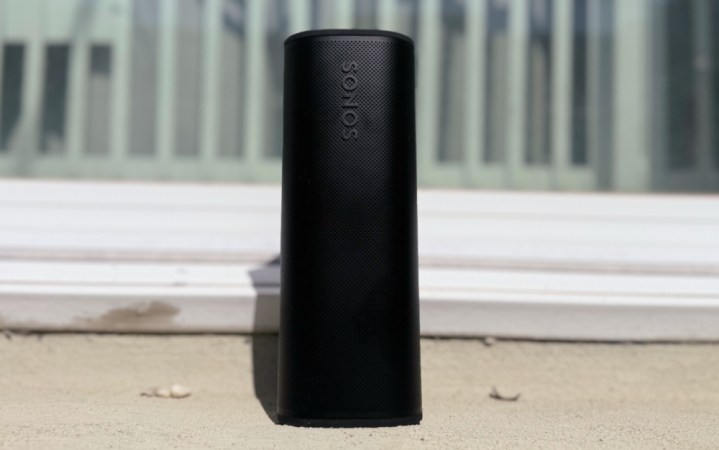We may earn revenue from the products available on this page and participate in affiliate programs. Learn more ›
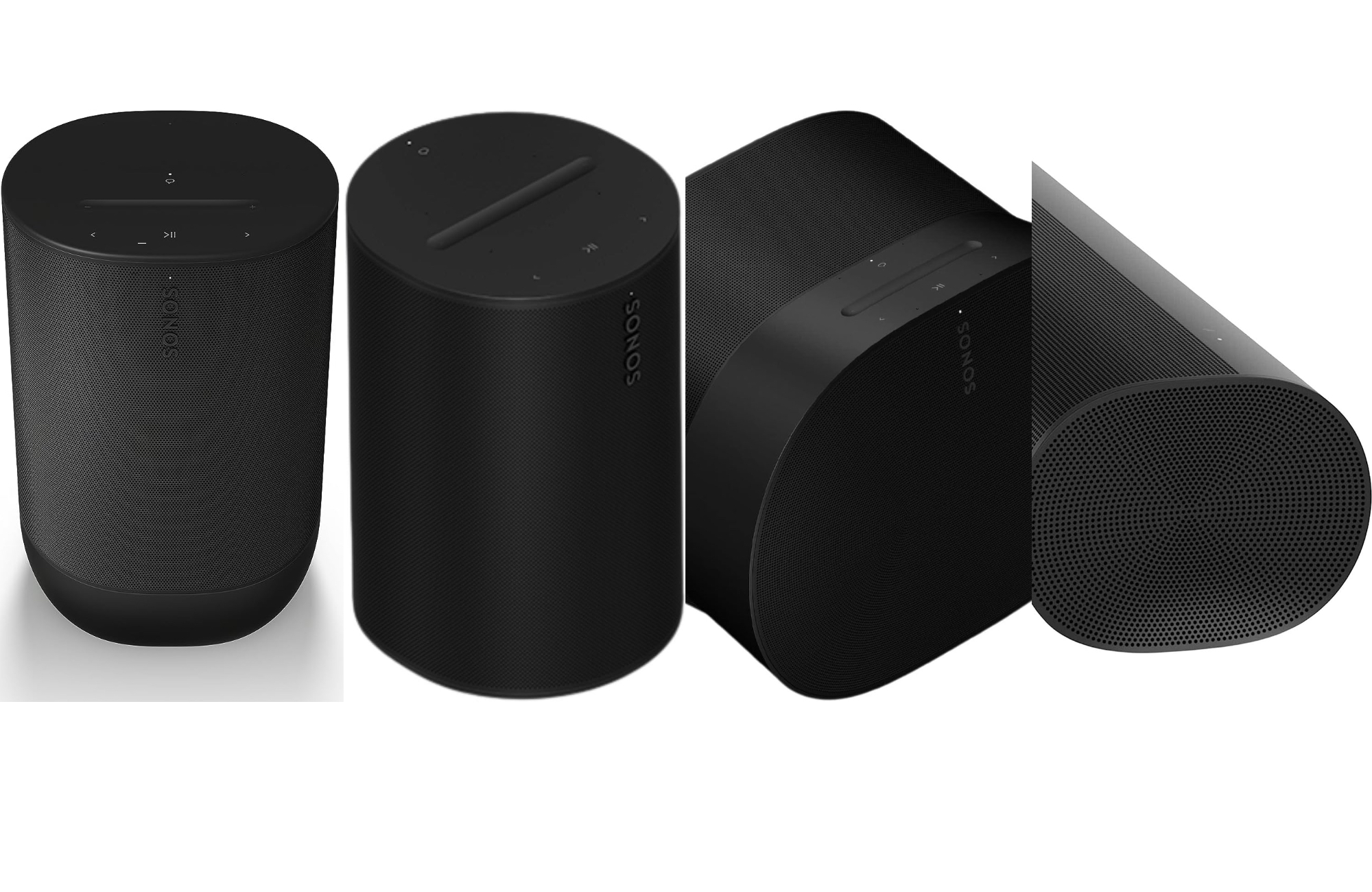
Sonos speakers are known worldwide for their sound quality and for pioneering and popularizing whole-home audio systems. The Santa Barbara, Calif.-based company’s original speakers were among the first to support Wi-Fi connectivity, the ability to play music through multiple wireless speakers simultaneously, and control via a mobile app. Sonos has continued its streak of innovation by introducing single-speaker Dolby Atmos support, sustainable speaker design, and the ability to communicate with multiple smart home assistants without compromising on the features that made it successful in the first place. Along the way, it’s also jumped head-first into the home theater world by introducing a line of soundbars that don’t sacrifice clarity for psychoacoustics. The best Sonos speakers will allow you to seamlessly set up a connected multiroom speaker system or home theater that requires little to no maintenance while delivering excellent sound.
- Best overall: Sonos Era 300
- Best splurge: Sonos Arc
- Best soundbar: Sonos Beam (Gen. 2)
- Best portable: Sonos Move 2
- Best value: Sonos Era 100
- Best budget: Sonos Roam 2
How we chose the best Sonos speakers
Our Sonos speaker recommendations are based on hands-on (and, in this case, ears-on) testing of every model we recommend. Our methodology included listening to music from different genres—in mono, stereo, and Dolby Atmos mixes—in different rooms at several volume levels. In the case of our portable speaker recommendation, we listened to music indoors and outdoors. When possible, we listened to music using different connectivity options. Sonos speakers are known for being pricy, so we also considered one’s budget when deciding which speakers to recommend.
The best Sonos speakers: Reviews & Recommendations
Ready to set up a wireless surround sound system or multiroom music system? Have your Wi-Fi router fired up and read on to find the best Sonos speaker to order and add to the network. In many cases, the play is to start with a single speaker and continue adding to your system over time. The good news is that Sonos speakers all sound pretty great on their own, so you won’t end up with a sub-par base system no matter your first pick. Consider, however, how you want to use the speaker—listening to music vs. watching movies and TV shows, for example—when choosing.
Best overall: Sonos Era 300
Sonos Era 300
Specs
- Connectivity: Bluetooth, Wi-Fi, 3.5mm AUX jack (with an adapter)
- Dolby Atmos compatible: Yes
- Price: $449
Pros
- Single-unit Dolby Atmos support, plus rear channel performance w/ upfiring/side drivers
- Sustainable design
- Modular connectivity options
Cons
- Price
The Sonos Era 300 wowed us when we first tested it in 2023, and it continues to impress all these months later. The speaker is one of the first to be able to decode and natively play back Dolby Atmos mixes from streaming services like Apple Music, Amazon Music, and TIDAL wirelessly from a single source (albeit through the use of the Sonos app). This feature comes courtesy of a six-driver array that is positioned forward and upward to offer greater depth. The upward-firing drivers won’t pull as much weight when listening to stereo or mono music (though they won’t hurt, either). For even better stereo and Dolby Atmos performance, you should consider adding a second Era 300 and pairing the two together.
As we said in our first impressions, “… the Era 300’s directional treble adds expansiveness alongside expressiveness.” The multiple drivers’ purpose-driven placement allows for the Era 300 to take full advantage of spatial audio‘s 360-degree encoding, keeping all the object-based elements in motion without any perceivable channel-hopping disconnection. In general, Sonos speakers have a midrange saturation, a rich house tuning, but it isn’t distracting; the center image remains focused, never shouty, while other frequencies are allowed to frolic. While the Era 300 won’t dethrone our top picks for best powered speakers when it comes to the ultimate expression of textural articulation and pure punchiness, it’s a speaker that’s much easier to mesh into any environments than component systems that need exact placement and multiple plugs. Go with the Era 300 if you want to spend more time with your playlists than playing with your speaker’s angle.
The Era 300 also benefits from Sonos’ latest design principles, which put sustainability and modularity front and center. The speaker has a USB-C port around the back, which can connect an adapter that terminates into a standard 3.5mm audio jack. This allows you to connect the Era 300 to a turntable with a built-in preamp and other wired audio sources (or go completely wirelessly with the Works with Sonos Victrola Stream Carbon or Victrola Stream Onyx). This new design is also among Sonos’ most sustainable—the speaker was designed to be taken apart by a technician, who can replace specific components rather than scraping the speaker outright. If you plan on paying $449 for a single speaker, investing in one designed to last is smart.
The Sonos Era 300 is the company’s latest high-end speaker, and we never found it lacking. This would be our immediate pick if we could only recommend one of its speakers.
Best splurge: Sonos Arc
Sonos Arc
Specs
- Connectivity: Wi-Fi, HDMI
- Dolby Atmos compatible: Yes
- Price: $834.99
Pros
- Rich sound
- Dolby Atmos support
- Wide size
Cons
- Price
At 45 inches wide and $834.99, Sonos’ Arc is the audio embodiment of the adage “Go big or go home.” Nearly four years after its release, it’s still competitive with the best Dolby Atmos soundbars, including JBL’s Bar 700 and Yamaha’s True X Bar 50A. As with the Era 300, the Sonos Arc features both upward and front-firing drivers, and the soundbar’s extremely wide size makes it a great choice when listening to stereo music or watching older TV shows and films. There’s a surprising amount of Left/Right channel separation, nowhere near the soundfield/imaging of discrete stereo speakers but somewhat akin to what we’ve experienced when listening to music on Bowers & Wilkins’ football-shaped Zeppelin speaker (albeit without the surprisingly prodigious bass that smart speaker produces). You’ll need enough space in your home theater to fit it, but you’ll rewarded for giving the Arc as much room as you can spare.
A big part of the Arc’s appeal is that it can convincingly replace a traditional 3.0 home theater system. Dialogue comes through clearly in the center channel, never getting overpowered by sound effects coming through the right or left channels. It’s a neat trick that the soundbar does this work for you rather than requiring you to enable a dialogue enhancement feature separately. Another benefit to the Arc is its ability to be connected with the company’s other speakers to form a more traditional multi-speaker home theater system. For the best Dolby Atmos experience, pair the Arc with two Era 300 speakers and its Sonos Sub.
While we prefer the Era 300 x2 and full-sized Sub setup, we’ve tested the Arc independently and paired just with a Sonos Sub Mini. It performed well in all cases, but the addition of a wireless subwoofer did round out its sound quite a bit. Sonos’ commitment to continuing to support older hardware by making it compatible with newer components is refreshing and helps to justify the Arc’s undeniably high cost. If you want a true home theater all-in-one, and have the space and budget, don’t hesitate to pick up the Sonos Arc.
Best soundbar: Sonos Beam (Gen. 2)
Specs
- Connectivity: Wi-Fi, HDMI, Optical (via included adapter)
- Dolby Atmos compatible: Yes
- Price: $499
Pros
- Great sound, given its compact size
- Modular design
- Dolby Atmos support
Cons
- Price
The second-generation Sonos Beam takes most of what we liked about the Sonos Arc and shrinks it down into a more manageable size. Dolby Atmos support is the Beam’s standout feature, given its relatively compact size, but its drivers are positioned forward and angled toward the sides, so the overhead/virtual surround sound effect wasn’t as pronounced during our tests. The outward-facing drivers made listening to stereo audio more convincing, though the Arc beat it out. Comparing the second-generation Beam to the Sonos Arc isn’t very fair, given the $400 price delta between the two, but Sonos’s smaller soundbar does stand out on its own.
Audio quality for both music and when watching videos was universally excellent in our tests. The front-firing center channel speakers matched the Arc in dialogue clarity, which was no small feat. Also, loud sounds like explosions never distorted the side speakers, which isn’t always true with smaller drivers found on more compact soundbars. You’ll get a relatively immersive stereo experience, while the ability to natively play Dolby Atmos mixes of albums and movie soundtracks is a nice bonus.
The main reason the second-generation Sonos beam stands out in a crowded field full of great options—Polk’s Signa S4, TCL’s Q6510, and Sony’s HT-S2000 among them—is the ability to connect it to Sonos’ other speakers. We paired the second-generation Sonos Beam with a Sub Mini and immediately noticed its sound filled out. Connecting it to a pair of Era 300s would’ve completed the effect and brought true Dolby Atmos playback to the soundbar. This flexibility, combined with the second-generation Beam’s impressive audio quality, makes it the soundout choice in the Sonos soundbar lineup.
Best portable: Sonos Move 2
Specs
- Connectivity: Wi-Fi, Bluetooth,
- Dolby Atmos compatible: No
- Price:
Pros
- Exceptional audio quality
- Portable-friendly design
- Sustainable design
Cons
- Price
The Move 2 is Sonos’ latest portable speaker, improving upon the previous generation in every conceivable way. Its battery lasts up to 24 hours (up from 11), its acoustic architecture was completely reconsidered (incorporating innovations from the Era 100’s development), and its design was tweaked to make it even easier to grab and go—literally. Our testing revealed a portable party speaker that stood out in an incredibly crowded field, largely thanks to Sonos’ strong out-of-the-box audio quality. It’s hard to argue with a portable speaker that sounds just as good over Wi-Fi and Bluetooth (though range gives the former the edge) without any EQ futzing necessary.
Part of that audio quality comes down to the Move 2’s support for TruePlay, a feature that automatically calibrates the speaker based on its environment. We found this allowed the Move 2 to sound great inside and outdoors, with perceptible differences in its sound when the feature was enabled. TruePlay works in real-time, so you’ll hear the speaker change when you take it from room to room, though your ears will adjust to its current sound quickly. Don’t get us wrong, the differences aren’t night and day, but they’re noticeable nonetheless.
The Move 2 benefits from Sonos’ latest design language, both inside and out. The multi-driver system inside the Move 2 is similar to the one found in our next featured speaker (see the budget pick below). This allows it to play music in true stereo on its own—though not Atmos, even if two Move 2s are connected—with enough oomph to fill out an entire mid-sized room on its own. Audio quality is consistent at any volume level, assuming the music you’re listening to was mixed and mastered well.
A big part of the Move 2’s appeal in our tests was its portable-friendly design. Sonos scooped out a chunk from the speaker’s back to act like a handle, and this recessed section allowed us to securely carry the Move 2 around single-handedly (and a solidly weighted base means it doesn’t tip over easily). This was a much more elegant design than portable speakers with traditional handles like JBL’s exceptional-sounding Authentics 300, which also impressed us last year. The Move 2 also features Sonos’ sustainability-forward design language, which means it can be disassembled and repaired more easily than the company’s earlier portable speakers.
All of these features give the Move 2 a distinct advantage over its competition and prove Sonos’ ability to bring audiophile quality outdoors.
Best value: Sonos Era 100
Specs
- Connectivity: Wi-Fi, Bluetooth, AUX (with an adapter)
- Dolby Atmos compatible: No
- Price: $249
Pros
- Great overall sound
- Sustainable design
- Price
Cons
- No Atmos support
- Not truly portable despite compact size (no battery)
The Era 100 is Sonos’ newest entry-level speaker, and we found it’s a big leap forward in audio quality over the speaker it replaced. The multi-driver array in the Era 100 allows it to play music in true stereo, and while separation is somewhat limited, it’s a better representation of an artist’s vision than truncating music into mono. The stereo separation becomes more pronounced when listening to music from a distance of four or more feet away.
Because this is the little sibling to Sonos’ Era 300 speaker, the two share many common features: The Era 100 has a sustainable design and a USB-C port that can terminate into a 3.5mm audio jack with an adapter. Support for TruePlay 2 helps the speaker sound great in any environment, so you don’t have to worry about finding a sweet spot. This feature, combined with Sonos’ in-house tuning and the Era 100’s audio processor and amp, add up to one fine-sounding speaker.
The Era 100 sounded rich and detailed when listening to music streamed from Apple Music over Wi-Fi or Bluetooth. Bass was present but controlled, highs sounded crisp without being too sharp, and the midrange was especially rich and luscious. The result is a speaker particularly good at playing back live and acoustic tracks and can present nuance in vocals especially well. Don’t worry; you’ll still find a lot to love about the Era 100 if you prefer techno, rap, or pop music layered with effects.
Given the price of Sonos’ speakers, we’re impressed the company spent so much time tweaking the sound of its entry-level speaker. For many, the Era 100 will be the best-sounding speaker in their home, and there won’t be a need to add a second for additional stereo separation. In a home theater environment, a pair of Era 100 speakers can be used in conjunction with a second-generation Sonos Beam (or Arc, if you so choose) and Sub for a 5.1 surround sound setup. The only major feature the Era 100 lacks is support for Dolby Atmos playback. If that doesn’t matter to you, pick up the Sonos Era 100 with no reservations.
Best budget: Sonos Roam 2
Specs
- Connectivity: Wi-Fi, Bluetooth
- Dolby Atmos compatible: No
- Price: $179
Pros
- Excellent sound for its size
- Easier to toggle between Bluetooth and Wi-Fi
- Price
Cons
- Mono speaker
The Roam 2 is Sonos’ most portable, affordable speaker, and it’s the best-sounding wireless speaker at its size. The speaker stands just 6.61 inches tall and weighs under a pound, making it easy to carry around in your hand or in a backpack. Its subtle curved triangular shape made the speaker comfortable to grip and hold onto. The Roam 2 may be smaller than any other Sonos speaker, but it has all the company’s trademark features. It can be connected to Wi-Fi for wireless streaming through the Sonos App or AirPlay 2 on Apple devices, and it supports Automatic Trueplay, which changes the speaker’s sound in real-time based on its environment. You can also connect to the Roam 2 over Bluetooth when you’re on the go.
Sonos seems to be encouraging the use of Bluetooth with the Roam 2 because it added a dedicated Bluetooth button on the back of the speaker. The previous generation of Roam required you to set everything up over Wi-Fi and then hold down the power button for Bluetooth pairing, which would get confusing. This time around, holding down the Bluetooth button elicits a chime, and it’s directly in pairing mode. In our tests, the Sonos Roam 2 worked flawlessly over both Wi-Fi and Bluetooth (version 5.2, for those counting), never losing a connection in either case. The initial Wi-Fi setup was simple thanks to Sonos’ app, which found the Roam 2 within 10 seconds of the speaker being turned on. Similarly, a MacBook Pro and iPhone 15 Pro Max could pair with the speaker over Bluetooth without incident.
Overall, we thoroughly enjoyed listening to music, podcasts, and audiobooks through the Roam 2. Sonos managed to eke a lot of performance from a mono speaker, likely through its dual custom-designed amplifiers. We could crank the speaker up while listening to the raw power pop of Badfinger’s I Can’t Take It or the overly compressed Britpop stylings of Oasis’ Supersonic and still hear every element of the track. Vocals and acoustic instruments sound especially good coming from the relatively demure Roam 2. This doesn’t mean the Roam 2 can’t articulate bass. The prominent bass line in A Tribe Called Quest’s Buggin’ Out and Pink Floyd’s Money came through clearly without overpowering the other elements of either track.
The nature of mono speakers is that some tracks will inevitably sound better than others. The Roam 2’s processor does a good job of separating different sounds to avoid losing too much fidelity in a stereo mix, but you may hear a wonky track here and there. If you want to listen to tracks in true stereo, your options are to step up to the Sonos Move 2 or pick up a second Roam 2 to pair with your first as dedicated L/R channels. Regardless, if you’re interested in getting into the Sonos speaker ecosystem, the Roam 2 is an excellent place to start.
What to consider when shopping for the best Sonos speakers
There are many factors to weigh when deciding which is the best Sonos speaker for you. These are the ones we considered most important when compiling this story:
Connectivity
Sonos speakers support a wide range of wired and wireless connectivity options depending on when they were released and the type of speaker they are. All of Sonos’ speakers support wireless streaming over Wi-Fi, while some also work with Bluetooth. The latest Sonos speakers feature a USB-C port on the back, which allows you to connect them to a turntable via an adapter. Sonos’ soundbars are typically outfitted with an HDMI port but also come with an adapter that allows them to be connected to a TV’s optical audio port. Also, if you already have a pair of passive stereo speakers you love, there are AV receivers (like the Sony STR-AN1000) you can buy that are certified Works with Sonos to add connected capabilities into your existing system.
Dolby Atmos compatibility
Some of Sonos’ speakers have the native ability to play music and movie soundtracks with a Dolby Atmos mix thanks to an array of upward and front-facing drivers, which are positioned such that sound is broadcast not only at but above and to the side of you, with soundwaves bouncing off the ceiling/walls to virtualize surround sound. Dolby Atmos audio is still in its infancy, but it’s gaining ground in the mainstream more than previous multichannel formats such as quadraphonic LPs, SACDs, and DVD-Audio discs (even multichannel audio Blu-rays) because tracks can be streamed rather than requiring specific niche discs.
Sustainability
All of the speakers Sonos released in 2023—the Sonos Era 100, Era 300, and Move 2—were designed with sustainability in mind from the bottom up. These speakers have modular designs that allow Sonos to repair a faltering component rather than having to replace the entire unit. This will extend the life of the speaker for you.
FAQs
Yes. A single Sonos speaker does deliver excellent sound on its own, especially the Era 300 for music and the Arc for movies. However, pairing it with additional Sonos speakers may make certain functions, like listening to music in stereo or Dolby Atmos, a more engrossing experience.
Sonos speakers sound great out of the box, but you can enable a feature called TruePlay, which uses the speaker’s internal microphone (if available) to calibrate its sound based on the size of your room and its placement.
Yes. Sonos speakers were designed to be left on, as doing so will allow you to stream audio to them wirelessly at any time. Most Sonos speakers require an active Internet connection to function most optimally, which is why we also recommend keeping them connected.
This depends on its size and feature set. Our Sonos speaker recommendations range from roughly $250 to $850.
Final thoughts on the best Sonos speakers
- Best overall: Sonos Era 300
- Best splurge: Sonos Arc
- Best soundbar: Sonos Beam (Gen. 2)
- Best portable: Sonos Move 2
- Best value: Sonos Era 100
- Best budget: Sonos Roam 2
Sonos’ connected speakers continue to be among the best you can get, with the company continuing to push the bar with each successive generation. Its continued support for older speakers and a strong sustainability push with its latest models suggest the company understands that its audio gear is an investment. It doesn’t release speakers simply for the sake of having a new gadget on the market, and does a great job at ensuring its hardware lasts a good, long time. This commitment, combined with the continued addition of new technologies and features, make its speakers a fantastic choice for those just starting their elevated audio journey or those looking to see how good a wireless speaker can really sound.




